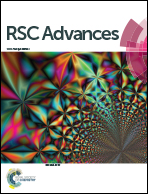Antibacterial textiles functionalized by layer-by-layer assembly of polyelectrolytes and TiO2 photocatalyst†
Abstract
The sprayed layer-by-layer assembly of TiO2 photocatalyst has been efficiently used for functionalizing polyester textiles and elaborating solar light active antibacterial textiles. Polyethylenimine (PEI) and polyanionic poly(styrene sulfonate) (PSS) polyelectrolytes have been used as polycation and polyanion layers, in alternation with dispersions of negatively- and positively-charged TiO2 particles, respectively. A synergistic effect resulting from both biocidal photocatalytic activity of TiO2 layers and biocidal activity of PEI layers within the multilayer system was put forward for explaining the high self-decontaminating activity of (PEI/TiO2)n functionalized textiles, 5 log of cell viability reduction being achieved with a single TiO2 layer at 50 μg cm−2. The sole solar light photocatalytic antibacterial activity of multilayer textiles was determined by masking the biocidal activity of PEI layers through the controlled assembly of PEI/(PSS/TiO2)n multilayers.


 Please wait while we load your content...
Please wait while we load your content...